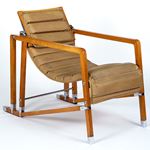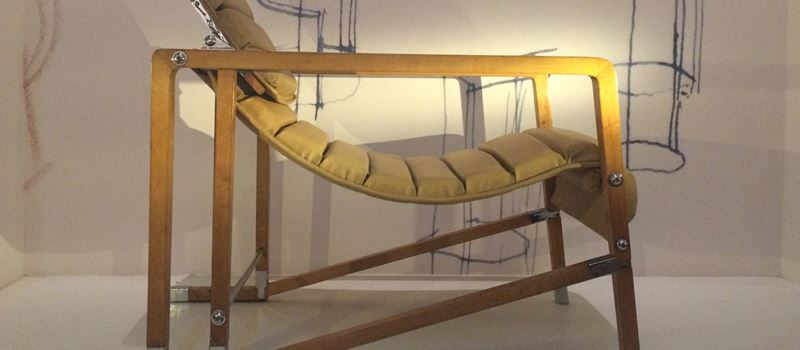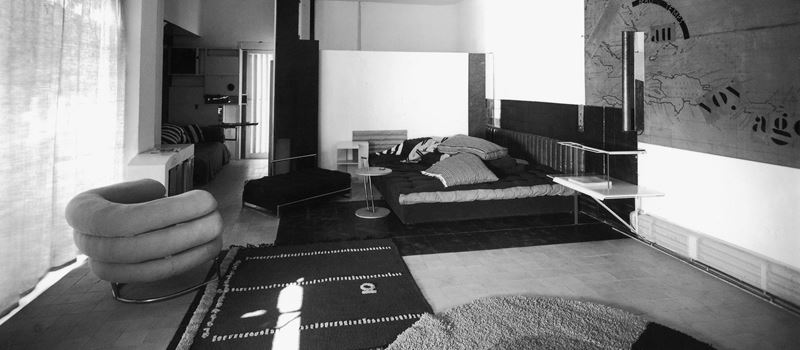The Ultimate NonConformist: Eileen Gray and the Transat Chair
- Product name
- The NonConformist Chair
- Designer
- Eileen Gray
- Country
- France
- Year made
- 1926
- Materials
- - Leather upholstry
- Chrome tubular steel
The Transat, short for Transatlantic, is a classic piece of Modernist furniture that is still reproduced today. Created by successful art deco designer Eileen Gray in the mid 1920s, it was part of a massive cultural and visual shift from the highly decorated and ornate styles popular before World War I towards a minimalistic, functional aesthetic.
"Nowhere did we attempt to create a line or a form for its own sake; everywhere we thought of the human being, his sensibility, his needs" Eileen Gray
Designed for her house, which overlooked the Mediterranean Sea, Eileen wanted the armchair to fit her exact needs and specifications, to be comfortable.






Simple looking, intricate design
Part of the beauty in the design of the Transat was in its simplicity. The straight wooden elements in the design may look like they'd be easy to make, but in actual fact the frame has to be handmade because of its complex joining system.
"Transatlantic luxury"
The Transat, named after transatlantic ocean liners instantly brings you into to the glamorous travel, adventure and luxury of the 1920s. The armchair is reminiscent of a deckchair found on such an ocean liner, and Eileen Grey created it to overlook the Mediterranean Sea in the house she designed on the French Riviera.
"Architecture in miniature"
Eileen Gray is appreciated for her modern way of mixing together elements of architecture with her interior designs. Her process was more closely related to the ideas of architecture of the time than to that of furniture design. Eileen made sure that all of her pieces were flexible in their uses, all the while experimenting with uses for new materials in modern environments. You can see a real sense of structure in the Transat chair.

Sycamore frame
Sycamore was chosen for the frame because of its flexibility and sturdy qualities. It's a pale coloured wood that was very fashionable in the 20s.
Chrome joints
Chrome was a relatively new material at the time, and Eileen Gray was one of the first interior designers to use chrome in furniture. The Bauhaus School of the Arts, which is still considered to be the most famous institute of design, were experimenting with new techniques and chrome at the same time as Eileen. She wasn't part of Bauhaus, and didn't benefit from the support, facilities and expertise, yet she managed to confidently and independently make it a successful part of her practice. Her explorations with chrome and tubular steel feature throughout her designs.
Leather cushioning
The foam cushioning that's in our chairs and sofas today hadn't been invented at the time Eileen first made this chair, so getting the upholstery to keep in its geometric shapes was difficult. They would instead stuff it with feathers, batting and other such fibres. Compared to the chairs we have today, this one probably wouldn't be as comfortable as it looks!

Commissioned by: Eileen
The Transat chair was made for Eileens beautiful house on the French Riviera. It was designed to be a comfortable place to look out over the stunning scenery. Her house was quite small and narrow, so the armchair had to be able to fit in and around her other furniture without sticking out.
The Transat today
Over time Eileen Gray has become increasingly popular, and this particular armchair is one of her most highly sought after designs. There were only 12 of its kind made originally, and one such piece is expected to make 1 million euros at auction. Incredibly, the Transat is still in production today!

An Irish designer in Paris
Eileen was born in Ireland and was brought up by her aristocratic mother into a wealthy elite. As Eileen grew up she decided to reject her affluent life to become an artist in Paris where she trained in the ancient Japanese art of lacquer, and from then grew in fame as a furniture designer and later as an architect. As time went on, her designs grew bolder and more abstract, and paved a course for Modernist furniture design.
A woman in a man’s business
At the time Eileen was setting out on her artistic journey, things were pretty tricky for female designers. At the time, artistic society found it hard to see how a woman could be as successful as a male designer, as design wasn't considered to be open to women. Even though men and women often worked together in the design room, women were rarely given credit for the work they did.
Designers like Eileen would have come across many boundaries to become successful. In some cases Eileen was still considered to be just a 'gifted amateur', even though she was one of the most successful modernist designers of her time.

On the Côte d’Azur
The original Transat chair was made specifically for her home on the Côte d’Azur, a beautiful home sitting on the edge of a rock face overlooking the beautiful ocean. This particular stretch of the French coast was well known for being a catalyst for artistic ideas and expression; this stretch of coast alone was known to be the home of other famous artists like Mattise and Picasso!
Explore other pages
EXPLORE A STORY
Memphis Group: awful or awesome?
In the early 80s, Italian designer and architect Ettore Sottsass founded Memphis, a group of artists and designers who became known for their bright and bold furniture design.
EXPLORE AN OBJECT
Morph folding wheel
When a British designer came up with a folding wheel that would help him transport his bike around the city he had no idea how it would go on to help so many people. Has he literally reinvented the wheel?
VIEW ALL OBJECTS
All Design Objects
Design influences our lives and can be found in every aspect of our day. Discover more inspiring and unique design objects